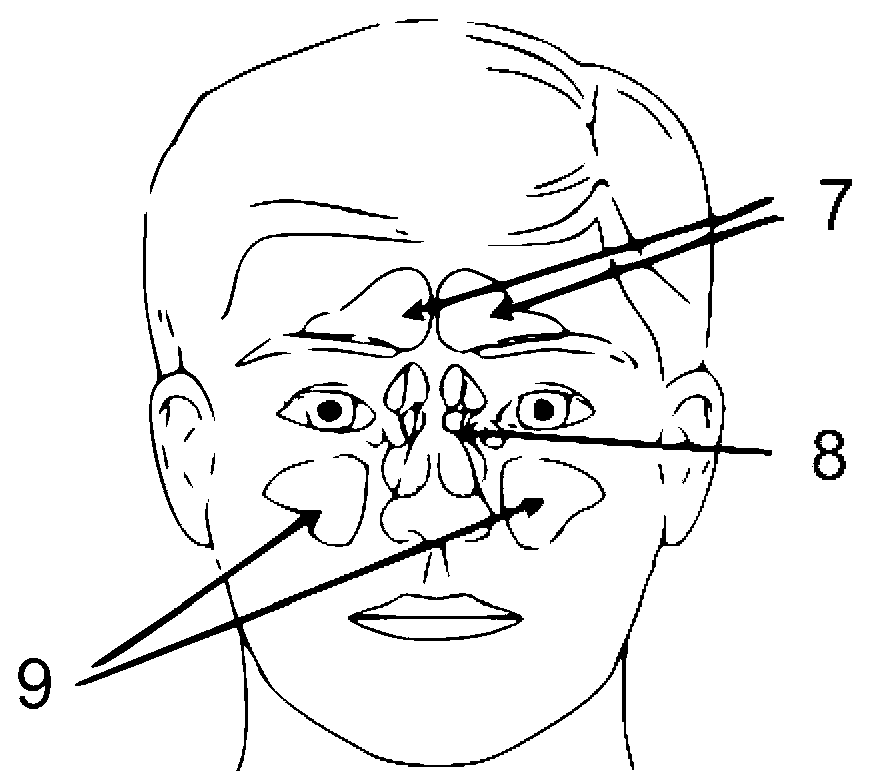Medicine spraying device for treating nasosinusitis or allergic rhinitis
A technology for allergic rhinitis and sinusitis, applied in the field of medical devices, can solve the problems of adhesion of inferior turbinate and nasal cavity side wall, incomplete coverage of lesions, damage to nasal branches, etc., to achieve the effect of improving treatment effect
- Summary
- Abstract
- Description
- Claims
- Application Information
AI Technical Summary
Problems solved by technology
Method used
Image
Examples
Embodiment 1
[0037] Such as figure 2 As shown, the spraying device for treating sinusitis or allergic rhinitis according to a preferred embodiment of the present invention includes an outer tube 1 and an inner tube 2 , wherein the outer tube 1 and the inner tube 2 extend coaxially and axially. The distal opening 3 of the inner tube 2 is in figure 2 is shown as housed in the outer tube 1, while in image 3 is shown axially protruding from the outer tube 1 .
[0038] From image 3 It can be seen from FIG. 1 that the tube body near the distal opening 3 of the inner tube 2 is split in the circumferential direction (with a slit 31 ), thereby forming a radially expandable split opening, shown as a V-shaped split opening.
[0039] The distal opening 3 of the inner tube 2 leads directly to the lesion, while the proximal opening 4 is connected with a luer joint or a ribbed joint or a trumpet-shaped joint, so as to be connected with a small vacuum suction device and a drug storage container (no...
Embodiment 2
[0057] The spraying device for treating sinusitis or allergic rhinitis according to this embodiment is similar to Embodiment 1, including an outer tube (not shown) and an inner tube 20, wherein the outer tube and the inner tube 20 are coaxial extend. Different from Embodiment 1, the tube body near the distal opening 30 of the inner tube 20 does not have cracks, but is circumferentially continuous, such as Figure 4 shown.
[0058] Near the distal opening 30 , two spring bodies 21 respectively extend radially outward from the outer surface of the inner tube 20 . One end 21a of the spring body 21 can be fixedly connected to the outer surface of the inner tube 20 by any suitable means. The other end 21b of the spring body 21 respectively abuts against the two support plates 22 , of course, the other end 21b of the spring body 21 can also be fixedly connected to the support plate 22 by any suitable means. The axially extending support plates 22 are each arranged perpendicular t...
Embodiment 3
[0062] The spraying device for treating sinusitis or allergic rhinitis according to this embodiment is similar to Embodiment 2, including an outer tube and an inner tube extending coaxially and axially, and the distal opening and the proximal opening of the inner tube are circumferentially continuous opening. The difference from Embodiment 2 is that there is no support plate near the opening of the distal end of the inner tube, and the spring body 210 and the recovery line 230 are also different from Embodiment 2, such as Figure 5 shown. The two ends 210a and 210b of the spring body 210 protruding axially from the inner tube are respectively fixed near the distal opening of the inner tube, and the recovery wire 230 runs through the spring body 210 and extends toward the proximal opening.
[0063] In the first state, the distal opening is accommodated in the outer tube, and at this time the spring body 210 is also accommodated in the outer tube and presents a compressed state...
PUM
| Property | Measurement | Unit |
|---|---|---|
| The inside diameter of | aaaaa | aaaaa |
| The inside diameter of | aaaaa | aaaaa |
| Particle size | aaaaa | aaaaa |
Abstract
Description
Claims
Application Information
 Login to View More
Login to View More - R&D
- Intellectual Property
- Life Sciences
- Materials
- Tech Scout
- Unparalleled Data Quality
- Higher Quality Content
- 60% Fewer Hallucinations
Browse by: Latest US Patents, China's latest patents, Technical Efficacy Thesaurus, Application Domain, Technology Topic, Popular Technical Reports.
© 2025 PatSnap. All rights reserved.Legal|Privacy policy|Modern Slavery Act Transparency Statement|Sitemap|About US| Contact US: help@patsnap.com



